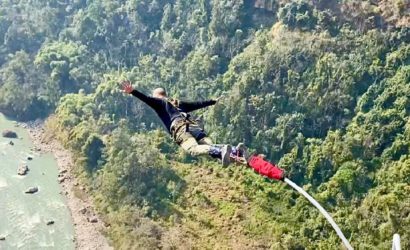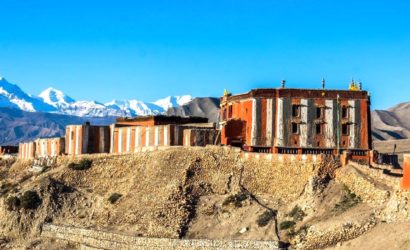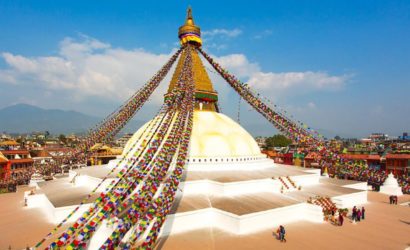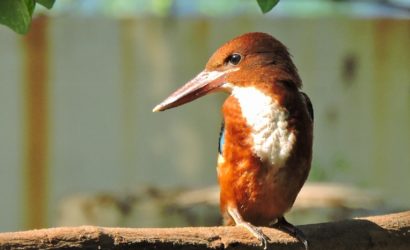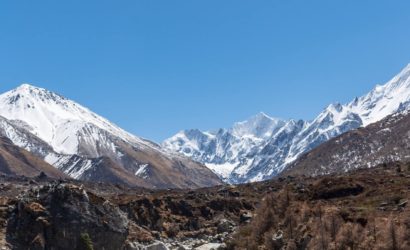The Mardi Himal Trek is one of the Annapurna Region’s hidden gems. Where most people would trek to Annapurna Base Camp, you have the opportunity to trek around the corner and get off the beaten trail. This hiking adventure takes you to the Mardi Himal base camp, which is located in the laps of Mardi Himal and Machhapuchhre, and is known as Fishtail.
Mardi Himal Trek is a perfect choice for travelers with limited time but seeking a beautiful trekking experience in Nepal. This trek offers wonderful a solitary walk on the Annapurna region‘s remote trails. Mardi Himal Trek is a short and moderate trek which is ideal for both beginner and experienced trekkers.
Mardi Himal is located in Nepal’s Mid-Western region and it’s an amazing peak within the Annapurna Mountain Subrange of the Himalayas. At an altitude of 5,587 meters (or 18,330 ft) it stands east of the Annapurna base Camp Trail.
Nestled in the Gandaki Province of Nepal, within the Annapurna Conservation Area, the Mardi Himal region boasts abundant natural beauty and diverse flora and fauna.
The Mardi Himal Trek 7 Days package provides an opportunity to explore this rich region. Starting from Pokhara, the trek leads through untouched landscapes with stunning views.
Mardi Himal’s biodiversity comprises vegetation, rocky fields, grass, and clean environment. It also offers breathtaking views to its north towards Mardi Himal and other great mountains such as Machhapuchhre (Fishtail Mountain), Annapurna South and Hiunchuli.
In summary, Mardi Himal provides a rewarding trekking experience for those seeking a quieter and less crowded alternative to some of the more famous trekking routes in the Himalayas of Nepal.
Best Time to Trek Mardi Himal
The best time to go trekking in Nepal is from mid-September to early December. Without a doubt! This also applies to the Mardi Himal Trek.
If you trek from February to April, you will be trekking at the second best time of year for the Mardi Himal Trek. Despite the fact that it is the end of the dry season, it still offers the best weather.
Winter lasts from December to January. The sky is clear. However, the temperature is pretty low and difficult to adjust to. Also, there could be a plenty of snow on the trail. Heavy snowfall and blizzards could cause the passes close.
Late May to June is pre monsoon season in Nepal. It’s pretty hot. During this time, you will see valleys blooming rhododendron flowers. The aroma of wildflowers will invite you to discover the beautiful trails.
June to mid-September is the time for heavy rainfalls and cloudy skies bringing monsoon rain. The monsoon season is not the ideal time to trek Mardi Himal, but still doable!
Required Permits for Mardi Himal Trek
When embarking on a journey to Mardi Himal in Nepal, it’s crucial to understand the permits required and their associated costs. These permits not only regulate trekkers but also play a vital role in the conservation of the stunning Annapurna region.
The Mardi Himal Trek requires two compulsory permits. First, it involves TIMS (Trekker’s Information Management System) Card, and second is ACAP (Annapurna Conservation Area Project) Permit. The cost of these permits are given below:
For International Travelers:
TIMS Card (Trekkers’ Information Management System):
- Individual: NPR 2000 or USD 18
- Group: NPR 1000 or USD 9
The TIMS card is a key document for individual and group trekkers from outside SAARC countries. It helps track trekkers, ensuring their safety and providing valuable data for emergency response.
ACAP (Annapurna Conservation Area Project):
- Cost: NPR 3000 or USD 27
This permit is required since the trail to Mardi Himal touches some part of Annapurna region too. The ACAP permit fee contributes to the conservation and sustainable development of the Annapurna region.
For SAARC Countries Travelers:
TIMS Card (Trekkers’ Information Management System):
- Individual: NPR 300 or USD 2
- Group: NPR 600 or USD 4
Trekkers from SAARC countries have reduced permit fees, making it more accessible for travelers from neighboring nations.
ACAP (Annapurna Conservation Area Project):
- Cost: NPR 1000 or USD 9
SAARC trekkers also contribute to the conservation efforts by obtaining the ACAP permit, although at a reduced rate.
These permits are crucial for your safety, trekking activities, and the preservation of the natural beauty in the Annapurna region. Make sure to obtain the necessary permits and enjoy your Mardi Himal trek while supporting the conservation efforts.
Guides & Porters
- The Crucial Role of Guides
- Experience and Local Knowledge
Hiring an experienced guide is imperative for a successful Mardi Himal Trek. These guides possess an in-depth knowledge of the local terrain, weather conditions, and trekking routes. Their experience ensures that you can navigate the sometimes challenging paths with ease, while they share their insights into the culture, flora, and fauna of the region.
Safety During Trek
Safety is a paramount concern when trekking in the Himalayas. Experienced guides are well-versed in first aid and can provide immediate assistance in case of emergencies. From altitude sickness to minor injuries, their quick response can make a life-saving difference.
Cultural Experience
The Mardi Himal region is rich in culture, and guides can provide valuable insights into the traditions and lifestyles of the local communities. This adds depth and cultural enrichment to your trekking experience.
Role of Porters
Lightening Your Load
Trekking in the Himalayas involves carrying essential gear and supplies. Porters play a crucial role in lightening your load. They will carry your heavy backpack, leaving you free to enjoy the trek without the burden of excessive weight.
Supporting Local Communities
Hiring local porters contributes to the economic well-being of the remote communities along the trekking routes. Your decision to employ porters helps these communities by providing employment opportunities, and it also ensures you have local expertise at your service.
Cost of Mardi Himal Trek
Itinerary Cost:
Mardi Himal 7 Days Trek in Himalaya Discovery starts from USD 665. This package comprises several terms and conditions, including cost includes and excludes. Fees of permits, accommodations, guides & porters are included. However, the cost of international flights, tips for guides and porters, and evacuation activities are excluded.
Remember, this cost is only for the Mardi Himal Trek 7 Days Package. There are several other packages for Mardi Himal Trek, which comes with several price tags.
Guides & Porter Cost:
Guides and porters also charge you some portion of your trekking package cost. On average, the cost of a guide ranges anywhere from $25 to $35 per person. Similarly, the cost of porters will range from $20 to $30 per person.
The important thing to consider here is that the experience, seasons of your trek, and itinerary will make a huge difference in their cost.
Mardi Himal Trek Map
Welcome to the Himalayas. Our officials will escort them into their respective hotels and bring at our Himalaya Discovery Office for the trek description.
There will be a welcome program after which trekkers will return to their hotels for an overnight sleep.
Today, we will leave the capital city of Nepal and head towards Kande. This will be our beginning of the Mardi Himal Trek. We will travel from Kathmandu to Kande in a compact Toyota Hiace, following the Prithvi Highway that links Kathmandu and Pokhara. The route offers scenic views of the majestic Himalayas alongside the Trisuli River.
Similarly, the green forests, terraced fields, and ever-flowing rivers will offer a soothing experience throughout our ride.
Upon reaching Kande, our journey begins. The trail is initially steep until Australian Camp, after which it becomes a comfortable and leisurely walk to Pothana.
Today’s trek is short and straightforward, providing an opportunity to acclimate to hiking in Nepal. We will spend the night at a guesthouse.
Today’s trek starts from Pothana and ends in Forest Camp. To reach there, we will diverge from the main Annapurna Base Camp route and follow the remote path through the dense forest of oak, bamboo, and rhododendron.
The trek is 4 to 5 hours long, where we will enjoy the majestic views of Annapurna and Dhaulagiri. A few hours of trek from Pothana, we will reach Deurali.
After hiking for the next few hours, we will finally reach Forest Camp, where we will accommodate at one of the Forest Camp Lodges. These lodges feature wood fireplaces, and there are three available. Overnight stay at the guesthouse.
On the fourth day of the Mardi Himal Trek, our goal is to reach Badal Danda, a captivating viewpoint along our route. Departing from Forest Camp, we’ll follow a secluded trail through a lush, biodiverse forest.
The trek offers stunning views of Mt. Machapuchhre (Mt. Fishtail) as we progress up the valley. Even within the forested surroundings, we’ll be treated to breathtaking glimpses of the majestic ‘Fishtail’ to the North.
Our day concludes with a well-deserved rest at a tea house in Badal Danda.
Today’s day starts with breakfast at Badal Danda. After that, we will continue our trek towards High Camp at 3580 meters above sea level. Our journey progresses along the Mardi Himal ridge, primarily through shrubbery with occasional rhododendron clusters along the path.
While we hike uphill through this trail, we will be welcomed with a splendid view of Annapurna South and Hiuchuli to the West. As we reach High Camp, we also can enjoy exceptional views of Hiuchuli and (Fishtail) Machhapuchhre, as well as Annapurna South.
From there, we can push our hike towards Mardi Himal Base Camp, which will be an exceptional hike. All in all, the mystic mountain peaks of Annapurna and Dhaulagiri range will be one of the astonishing factors of this trek.
Having reached the Mardi Himal Base Camp, it’s now time to begin our return journey. Initially, we’ll retrace our steps along the familiar trail back to Low Camp.
Upon reaching Low Camp, we’ll take a different route to complete the circuit. Instead of returning through Forest Camp, we’ll redirect our trail towards Siding village, a traditional local community that provides a more tranquil experience compared to mainstream tourist routes.
Optionally, if your time permits, spend an extra day in Pokhara and enjoy the delights of Pokhara, taking a trip to a spa massage or listening to live music. Or simply relax in a quiet café or restaurant with a view of the Fewa Lake.
Today, we drive back to Kathmandu. It will take about 7 hours, overland journey by tourist coach. And the gentle light brings us on our way back to the bustle of Nepal’s capital. In the evening we will have a farewell dinner in a traditional Nepalese restaurant with cultural performances.


